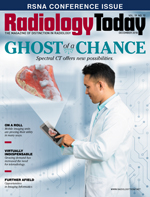 Molecular Imaging News: A New Link in the Chain
Molecular Imaging News: A New Link in the Chain
By Dave Yeager
Radiology Today
Vol. 19 No. 12 P. 6
Medical radioisotopes are crucial components of modern health care, but the supply chain that ensures access to them is fragile. For example, SNMMI issued a molybdenum-99 (Mo-99) shortage alert for the first half of November, due to a continuing outage at a reactor in South Africa and an unanticipated shutdown of a reactor in the Netherlands that coincided with a planned maintenance shutdown at a reactor in Australia. Mo-99 is used to make Technetium-99m (Tc-99m), which is the most commonly used medical radioisotope.
Complicating matters, Mo-99 has a two-and-a-half–day half-life, and Tc-99m has a six-hour half-life. Until recently, Mo-99 was imported exclusively from outside the United States and derived from uranium, which, for obvious reasons, is highly regulated. To address this supply chain uncertainty, NorthStar Medical Radioisotopes, LLC, developed the RadioGenix System, which was FDA approved in February, making the company the first domestic supplier of Mo-99 in three decades.
"Molybdenum from outside the US is generated from uranium using research reactors, and those are often old reactors. They have very complex maintenance and logistics schedules," says Stephen Merrick, the president and chief operating officer of NorthStar. "We're entirely domestic, and we don't use uranium; we actually use natural molybdenum, which is irradiated at the highly reliable University of Missouri Research Reactor."
An additional FDA approval that NorthStar received in August allows them to manufacture RadioGenix Systems and Mo-99 at their facility in Beloit, Wisconsin. RadioGenix Systems are installed on-site at radiopharmacies, and staff at those facilities use the systems to elute Tc-99m from Mo-99. NorthStar has developed a training program that staff must complete before they can be licensed to operate a RadioGenix System by the state or Nuclear Regulatory Commission region where they're located.
NorthStar trains radiopharmacy staff on seven operational protocols; the company also trains the facility's radiation safety officers. Once the training is complete, the facility can apply for a license, and, once the license is granted, the RadioGenix System can be installed. Merrick says it takes approximately a day and a half to install the system and an hour or two for the radiopharmacy staff to get the machine up and running. He adds that NorthStar's customers are on track with adopting the systems, and, although they are still at the beginning of the adoption curve, the company has trained more than 20 customers so far.
Efficient Processing
James Harvey, NorthStar's chief science officer, says the RadioGenix System was in development for many years. The technology was initially licensed in 2005, and it went through three prototypes before it became the RadioGenix System that was approved by the FDA earlier this year. Harvey says the system is different from most generators, which are dry generators that use aluminum to separate Tc-99m from Mo-99. The RadioGenix System uses a proprietary method to separate the radioisotopes. In addition to producing US Pharmacopeia–compliant Tc-99m, Harvey says batches can be logged, tracked, and linked to a pharmacy management system, something that current dry generators can't do.
"Because it is a system that we can build computer processes around, it can track what's happening, it can log every step, it can even produce an electronic batch record," Harvey says. "There are a number of enhancements and features that are offered that are not offered on the current dry generators."
Harvey says the ability to link to pharmacy management systems provides important operational information to radiopharmacy groups to make determinations about efficiency for each pharmacy in their chain. Among other features, he says the RadioGenix System is intuitive to use and comes with video guides to answer common questions. He adds that the waste from the RadioGenix process is much less radioactive than the waste from the uranium process. As much as Tc-99m is used, ease of use and less waste are important considerations.
"Moly is made every week in the United States because it can't be put on the shelf with that two-and-a-half–day half-life," Harvey says. "And with the six-hour half-life of technetium, pharmacists pretty much will elute several times a day. They may have multiple generators, but they'll make several elutions a day, in order to keep their processes efficient and functional."
Harvey adds that, although it is currently only approved for Mo-99, the RadioGenix System could potentially be used for other types of radioisotopes. NorthStar has tested separation methods for Bismuth-213 from Actinium-225, Rhenium-188 from Tungsten-188, and Gallium-68 from Germanium-68, but there are no radioistopes other than Tc-99m from Mo-99 in their immediate future.
"It is a platform technology," Harvey says. "We could deploy it in other nuclear medicine relationships. We have tested others, but the only one that is approved today, of course, is moly-tech separation that the FDA approved earlier this year."
— Dave Yeager is the editor of Radiology Today.

